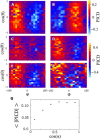Enantioselective fragmentation of an achiral molecule in a strong laser field
- PMID: 30873429
- PMCID: PMC6408155
- DOI: 10.1126/sciadv.aau7923
Enantioselective fragmentation of an achiral molecule in a strong laser field
Abstract
Chirality is omnipresent in living nature. On the single molecule level, the response of a chiral species to a chiral probe depends on their respective handedness. A prominent example is the difference in the interaction of a chiral molecule with left or right circularly polarized light. In the present study, we show by Coulomb explosion imaging that circularly polarized light can also induce a chiral fragmentation of a planar and thus achiral molecule. The observed enantiomer strongly depends on the orientation of the molecule with respect to the light propagation direction and the helicity of the ionizing light. This finding might trigger new approaches to improve laser-driven enantioselective chemical synthesis.
Figures




References
-
- Quack M., Stohner J., Influence of parity violating weak nuclear potentials on vibrational and rotational frequencies in chiral molecules. Phys. Rev. Lett. 84, 3807–3810 (2000). - PubMed
-
- Darquié B., Stoeffler C., Shelkovnikov A., Daussy C., Amy-Klein A., Chardonnet C., Zrig S., Guy L., Crassous J., Soulard P., Asselin P., Huet T. R., Schwerdtfeger P., Bast R., Saue T., Progress toward the first observation of parity violation in chiral molecules by high-resolution laser spectroscopy. Chirality 22, 870–884 (2010). - PubMed
-
- Quack M., How important is parity violation for molecular and biomolecular chirality? Angew. Chem. Int. Ed. Engl. 41, 4618–4630 (2002). - PubMed
-
- Lorenz H., Seidel-Morgenstern A., Processes to separate enantiomers. Angew. Chem. Int. Ed. Engl. 53, 1218–1250 (2014). - PubMed
-
- Martens J., Bhushan R., Purification of enantiomeric mixtures in enantioselective synthesis: Overlooked errors and scientific basis of separation in achiral environment. Helv. Chim. Acta 97, 161–187 (2014).
LinkOut - more resources
Full Text Sources

